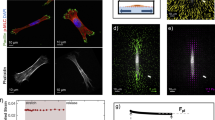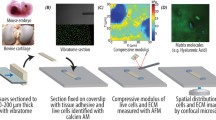Abstract
Although it is known that cells promote structural reorganization of the collagen architecture, how individual cells exert mechanical tension on the matrix is not clearly understood. In the present study we have investigated the mechanical interaction of individual corneal fibroblasts with a collagen matrix using an improved version of our previously described in vitro force-measurement system (Roy, P. et al. Exp. Cell Res. 232:106–117, 1997). The elastic distortion of the collagen matrix exerted by cells was temporally recorded and analyzed using a two-dimensional finite-element model to quantify the forces exerted on the matrix. Time-lapse videomicroscopy of serum-cultured cells on the matrix for up to 6 h revealed that individual fibroblasts generated measurable tension on the matrix during pseudopodial extension and slow retraction. Fast retraction, an event observed during active cell migration, was associated with dramatic release of tension on the matrix. An apparent inverse correlation was observed between cell translocation and maintenance of matrix tension. Additional experiments with cells under serum-free conditions revealed that these cells fail to generate any detectable tension on the matrix despite undergoing filopodial extension and retraction. Since serum-free cells do not form focal adhesions or stress fibers, these experimental data suggest that contractility of nonmotile cells, coupled with strong cell–matrix adhesion, is the most favorable mechanism of generating and maintaining tension on the extracellular matrix. © 1999 Biomedical Engineering Society.
PAC99: 8718Ed, 8715La, 8714Ee, 4266Ct, 0270Dh
Similar content being viewed by others
REFERENCES
Bellows, C. G., A. H. Melcher, and J. E. Aubin. Contraction and organization of collagen gels by cell cultured from periodontal ligament, ginigiva and bone suggest function cell differences between cell types. J. Cell. Sci. 50:299–314, 1981.
Burridge, K. Are stress fibers contractile? Nature (London) 294:691–692, 1981.
Burridge, K. Substrate adhesions in normal and transformed fibroblasts: Organization and regulation of cytoskeletal, membrane and extracellular matrix components at focal contacts. Cancer Rev. 4:18–78, 1986.
Chen, W. T. Induction of spreading during fibroblast movement. J. Cell Biol. 81:684–691, 1979.
Chen, W. T. Mechanism of retraction of the trailing edge during fibroblast movement. J. Cell Biol. 90:187–200, 1981.
Chrzanowska-Wodnicka, C., and K. Burridge. Rho-stimulated contractility drives the formation of stress-fibers and focal adhesions. J. Cell Biol. 133:1403–1415, 1996.
Craig, S. W., and R. P. Johnson. Assembly of focal adhesions: Progress, paradigms, and portents. Curr. Opin. Cell Biol. 8:74–85, 1996.
Cunningham, C. C., T. P. Stossel, and D. J. Kwiatkowski. Enhanced motility in NIH 3T3 fibroblasts that overexpress gelsolin. Science 251:1233–1236, 1991.
Danowski, B. A., and A. K. Harris. Changes in fibroblast contractility, morphology, and adhesion in response to phorbol ester tumor promoter. Exp. Cell Res. 177:47–59, 1988.
Darby, I., O. Skalli, and G. Gabbiani. α-smooth muscle actin is transiently expressed by myofibroblasts during experimental wound healing. Lab Invest 63:21–29, 1990.
Ehrlich, H. P. Wound closure: Evidence of cooperation between fibroblasts and collagen matrix. Eye 2:149–157, 1988.
Ehrlich, H. P., and J. B. M. Rajaratnam. Cell locomotion forces versus cell contraction forces for collagen lattice contraction: An in vitro model of wound contraction. Tissue Cell 22:407–417, 1990.
Elsdale, T., and J. Bard. Collagen substrata for studies on cell behavior. J. Cell Biol. 54:626–637, 1972.
Gabbiani, G., G. B. Ryan, and G. Majno. Presence of modified fibroblasts in granulation tissue and their possible role in wound contraction. Experientia 27:549–550, 1971.
Gabbiani, G., B. J. Hirschel, G. B. Ryan, P. R. Statkov, and G. Majno. Granulation tissue as a contractile organ: A study of structure and function. J. Exp. Med. 135:719–734, 1972.
Gabbiani, G., C. Chaponnier, and I. Huttner. Cytoplasmic filaments and gap junctions in epithelial cells and myofibroblasts during wound healing. J. Cell Biol. 76:561–568, 1978.
Grinnell, F., and C. R. Lamke. Reorganization of hydrated collagen lattices by human skin fibroblasts. J. Cell. Sci. 66:51–63, 1984.
Guidry, C., and F. Grinnell. Studies on the mechanism of hydrated collagen gel reorganization by human skin fibroblasts. J. Cell. Sci. 79:67–81, 1985.
Guidry, C., and F. Grinnell. Contraction of hydrated collagen gels by fibroblasts: Evidence for two mechanisms by which collagen fibrils are stabilized. Collagen. Relat. Res. 6:515–529, 1986.
Harris, A. K. Cell traction in relationship to morphogenesis and malignancy. Dev. Biol. 3:339–357, 1986.
Harris, A. K. ''Multicellular mechanics in the creation of anatomical structures.'' In: Biomechanics of Active Movement and Division of Cells, edited by N. Akkas. Berlin: Springer, 1994, Vol. H84, pp. 87–129.
Harris, A. K., D. Stopak, and P. Wild. Fibroblast traction as a mechanism for collagen morphogenesis. Nature (London) 290:249–251, 1981.
Harris, A. K., P. Wild, and D. Stopak. Silicone rubber substrata: A new wrinkle in the study of cell locomotion. Science 208:177–189, 1980.
Hay, E. D. Interaction of migrating embryonic cells with extracellular matrix. Exp. Biol. Med. 10:174–193, 1985.
Hay, E. D. Extracellular matrix, cell skeletons and embryonic development. Am. J. Med. Genet. 34:14–29, 1989.
Jester, J. V., W. M. Petroll, P. A. Barry, and H. D. Cavanagh. Temporal, three-dimensional, cellular anatomy of corneal wound tissue. J. Anat. 186:301–311, 1995.
Kimura, K., M. Ito, M. Amano, K. Chihara, Y. Fukuta et al. Regulation of mysoin phosphatase by rho and rho-associated kinase (Rho-kinase). Science 273:245–48, 1996.
Lauffenburger, D. A., and A. F. Horwitz. Cell migration: A physically integrated molecular process (Review). Cell 84:359–369, 1996.
Lee, J., M. Leonard, T. Oliver, A. Ishihara, and K. Jacobson. Traction forces generated by locomoting keratocytes. J. Cell Biol. 127:1957–1964, 1994.
Mar, P. K., J. Huang, P. Roy, H. Yin, H. D. Cavanagh, and J. V. Jester. Effects of gelsolin over-expression in SV-40 transformed rabbit corneal keratocytes. Mol. Biol. Cell 7:377a, 1996.
Mar, P. K., P. Roy, H. D. Cavanagh, W. M. Petroll, and J. V. Jester. Disruption of actin filaments by gelsolin overexpression impairs matrix reorganization. Invest. Ophthalmol. Visual Sci. 39:S35, 1998.
Martin, P. Wound healing—Aiming for perfect skin regeneration. Science 276:75–81, 1997.
Oliver, T., M. Dembo, and K. Jacobson. Traction forces in locomoting cells. Cell Motil. Cytoskeleton 31:225–240, 1995.
Rayan, G. M., and J. J. Tomasek. Generation of contraction of force by cultured Dupuytrens's disease and normal palmar fibroblasts. Tissue Cell 26::747–756, 1994.
Ronnov-Jessen, L., and O. W. Petersen. A function of filamentous α-smooth muscle actin: Retardation of cell motility in fibroblasts. J. Cell Biol. 134:67–80, 1996.
Rouslahti, E., and B. Orbink. Common principles of cell adhesion. Exp. Cell Res. 227:1–11, 1996.
Roy, P., W. M. Petroll, H. D. Cavangh, C. J. Chuong, and J. V. Jester. An in vitro force measurement assay to study the early mechanical interaction between corneal fibroblasts and collagen matrix. Exp. Cell Res. 232:106–117, 1997.
Roy, P., W. M. Petroll, H. D. Cavangh, and J. V. Jester. Exertion of tractional force requires the coordinated upregulation of cell contractility and adhesion. Cell Motil. Cytoskeleton 43:23–34, 1999.
Skalli, O., and G. Gabbiani. ''The biology of the myofibroblast relationship to wound contraction and fibrocontractive disease.'' In: The Molecular and Cellular Biology of Wound Repair, edited by R. A. F. Clark and P. M. Henson. New York, Plenum, 1988, pp. 373–402.
Stopak, D., and A. K. Harris. Connective tissue morphogenesis by fibroblast traction. Dev. Biol. 90:383–398, 1982.
Stopak, D., N. K. Wessels, and A. K. Harris. Morphogenetic rearrangement of injected collagen in developing chicken limb buds. Proc. Natl. Acad. Sci. USA 82:2804–2808, 1985.
Witke, W., A. H. Sharpe, J. H. Hartwig, T. Azuma, T. P. Stossel, and D. J. Kwiatkowski. Hemostatic, inflammatory and fibroblast responses are blunted in mice lacking gelsolin. Cell 81:41–51, 1995.
Author information
Authors and Affiliations
Additional information
Joint program in Biomedical Engineering between the University of Texas Southwestern Medical Center
Rights and permissions
About this article
Cite this article
Roy, P., Petroll, W.M., Chuong, C.J. et al. Effect of Cell Migration on the Maintenance of Tension on a Collagen Matrix. Annals of Biomedical Engineering 27, 721–730 (1999). https://doi.org/10.1114/1.227
Issue Date:
DOI: https://doi.org/10.1114/1.227




